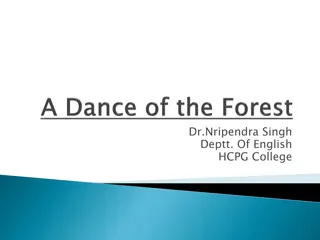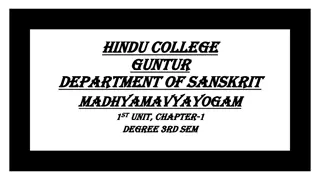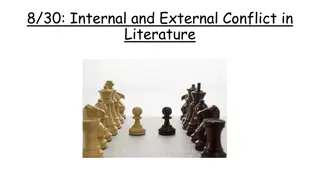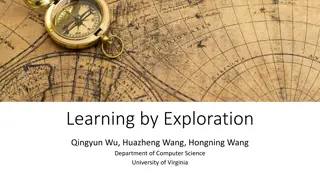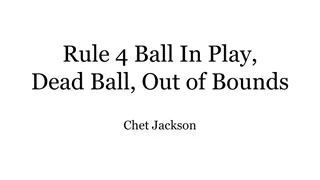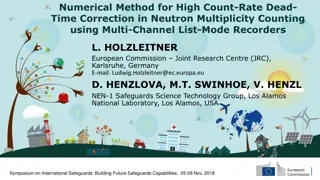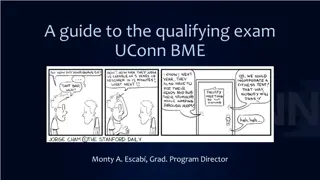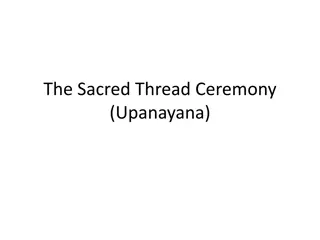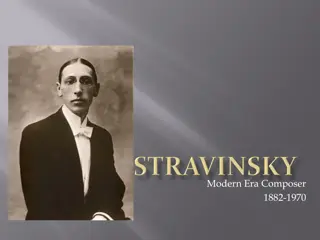Exploration of Brahmin Society in "Samskara: A Rite For A Dead Man
"Samskara: A Rite For A Dead Man" is a novel by U.R. Ananthamurthy that delves into the complexities of Brahmin society in a south Indian village. The story revolves around Praneshacharya, a priest faced with the dilemma of performing the last rites for Naranappa, a Brahmin who defied traditional norms. Through its narrative, the novel addresses themes such as rituals, untouchability, communal sentiments, and human frailties prevalent in Brahmin communities. The plot unfolds as Praneshacharya grapples with the repercussions of Naranappa's transgressions, encapsulating the tensions within traditional societal structures.
Download Presentation

Please find below an Image/Link to download the presentation.
The content on the website is provided AS IS for your information and personal use only. It may not be sold, licensed, or shared on other websites without obtaining consent from the author. Download presentation by click this link. If you encounter any issues during the download, it is possible that the publisher has removed the file from their server.
E N D
Presentation Transcript
Dr.Nripendra Singh Department of English HCPG College
Samskara: A Rite For A Dead Man is a religious novel about a deteriorating Brahmin colony in a south Indian village of Karnataka. Samskara translated into English from Kannada by A.K. Ramanujan, is a novel about the people in an Agrahara, Brahmins, contemplating about the last rites of a dead man of Brahmin caste but who breached his caste limits during his life time. This is also the subtitle of the novel, Rite for a Dead Man. Characters: Praneshacharya learned scholar and priest of Durvasapura Naranappa a Brahmin who leads a non-Brahminical life Chandri a dalit woman who lives with Naranappa Garudacharya a relative of Naranappa Lakshmanacharya a relative of Naranappa Dasacharya a poor Brahmin of the agrahara Durgabhatta a Smarta Brahmin living in Durvasapura Anasuya wife of Lakshmanacharya Sitadevi_ wife of Garudacharya Bhagirati_ wife of Praneshacharya, an invalid
o The novel seems an accurate estimate of Brahmin society in the 1960 s or more correctly the Brahmin societies of all times which suffer from the serious problems of backwardness despite having intellectuals among them. o Their energy is directed towards maintaining age-old convictions, beliefs, customs and superstitions. o Ananthamurthy raises sensitive issues like rituals , untouchability , sex, communal feeling and human weakness such as avarice,envy, selfishness.
o The name of the agrahara is Durvasapura because of alegendary story behind it. It was believed that Durvasa, a sage did penance on a hillock in the river,Tunga. The place became famous because of thelegendary story and also because of Praneshacharya. o Praneshacharya is the wise man in the agrahara. The entire colony came to his doorsteps every morning and evening to listen to his recitations of holy legends.
o The novel starts with the death of a member ,belonging to an orthodox clan of Brahmins, who do not follow the established customs. o Naranappa is the disreputed person of the agrahara who offends the whole community by indulging in forbidden things like wine and women, and meat-eating. o When he dies without an heir nobody from the Brahmin community agrees to perform his last rites due to the fear of disgracing their caste. o For getting a solution, they take the problem to Praneshacharya, the most revered person of the Agrahara.
o One day before eating his meal, Praneshacharya is going about his daily routine. At that time, he hears the sound of Chandri behind him calling Acharya . Chandri is a dalit. o If Praneshacharya talks to her, he would be polluted and should take bath before eating his meal. Nevertheless, he listens to her and she informs that Naranappa is dead after having fever for four days. o There is a belief that it is wrong to eat food before doing the funeral rites for the dead. So, Praneshacharya runs to Garudacharya s house to stop him from eating his meal and then both of them inform others in the agrahara. o Everyone in the agrahara thinks, Alive, Naranappa was an enemy; dead a preventer of meals; as a corpse, a problem, a nuisance. o The men and their wives assemble in front of Praneshacharya s house to hear his directions to solve the problem of Naranappa s rites. The women are with fear that their husbands should not accept to do the funeral rites. o Praneshacharya informs the people that there are two problems to be solved. The first problem is doing funeral rites for Naranappa and second is deciding the person for doing the rites, since Naranappa doesn t have children. Garudacharya, Dasacharya a poor Brahmin of the agrahara, and Lakshmanacharya acknowledge to the words of
o People in the agrahara cannot do the rites as Naranappa had relationship with a low-caste woman, Chandri and also ate the food she cooked. o Naranappa abandoned his legal wife and when she died he did not attend her funeral. o He does not observe the death anniversary of his parents. o In addition to all these sacrileges acts, he has also brought Muslims to the front yard of the agrahara to eat and drink forbidden things.
o Praneshacharya is confused whether to proclaim Naranappa as Brahmin or non-Brahmin. o Fearing that the Brahmins might not do the funeral rites for Naranappa, Chandri places all her gold ornaments in front of Praneshacharya, to be used for the expense of Naranappa s funeral rites. o While everybody thinks of a way out to do the funeral rites for Naranappa, Dasacharya suggests the idea of requesting the Parijatapura Brahmins to do the funeral rites for two reasons. o The first reason is Naranappa was friendly with the Parijatapura Brahmins o The other reason is that the Parijatapura Brahmins are Smarta Brahmins ,not as orthodox as the Madhvas. The Parijatapura Brahmins are pleasure lovers and some of them are rich as they run beetelnut farms.
o The family of Lakshmanacharya and Garudacharya are perturbed by the decision of Praneshacharya because the golden ornaments would be taken away by the person who does the funeral rites. o Praneshacharya goes through the palm leaf texts to find a solution to Naranappa s funeral rites while the Madva Brahmins are in Parijatapura to inform about Naranappa s death. o The thought of Naranappa makes Praneshacharya realize how he has been a problem all through his life. o Praneshacharya recollects a bitter conversation when he went to Naranappa s house to meet him. Naranappa disrespected and treated him with contempt.
o He also remembers how Naranappa made Garudas son Shyama and Lakshmana s son-in-law Shripati to go astray from Brahminical tradition. Shyama ran away from home and joined the army, while Shripati almost took the lifestyle of Naranappa. o He even remembers the day when he brought Muslims with him to the Ganapathi temple stream and caught the sacred fish. During their heated conversation Naranappa has said, I ll destroy Brahminism, I certainly will. My only sorrow is that there s no brahminism really left to destroy in this place except you. o Praneshacharya does a detailed and prolonged search of the scriptures without success. Then he retires for meditating in the Maruti temple hoping for God s guidance for disposing the body. o For solving the problem the Brahmins seek help from a colony in the neighbourhood (Parijatapura) and later, a monastery.
o The stench of dead rats and Naranappas dead body makes the night sleepless for many in the agrahara. oNaranappa died of bubonic plague. o Meanwhile, there is a break out of plague in the agrahara due to Naranappa's rotting corpse. o Praneshacharya becomes frustrated due to his inability to arrive at a decision. As he staggers out of the temple he sees Chandri, the low-caste mistress of Naranappa. Praneshacharya is physically attracted to Chandri and the two make love, thus ending the Acharya s celibacy. o This incident is a turning point in Praneshacharya s life. Meanwhile his wife dies due to the plague. He cremates his wife and then leaves the agrahara not able to confront the people who had respected him until then as a learned teacher.
o Praneshacharya, long devoted entirely to the cause and tradition, is forced (and/or allowed) by circumstance to question it, freed, over the course of the story, from several of his burdens. o However, Ananthamurthy does not offer a resolution here: Samskara remains open-ended. Samskara means religious purificatory rites and ceremonies for sanctifying the body , mind and intellect of an individual so that he may become a full-fledged member of the community. o A rite of passage or life-cycle ceremony; the realizing of past perceptions. o In trying to resolve the dilemma of who , if any , should perform the death- rite(a samskara), the Acharya begins a samskara ( a transformation) for himself. o Praneshacharya undergoes the process of purification. He shifts from a hardcore ritualistic Brahmin to a realist. o A rite for a dead man becomes a rite of passage for the living. o In life as in death, Naranappa questioned the Brahmins of the village, exposed their Samskara ( refinement of spirit , maturation through many lives) or lack of it.
o Naranappa a catalytic agent who affects change, favors modernism, rejects brahminhood and brings home Chandri, a prostitute, from Kundapura, a nearby town. He drinks alcohol and invites muslims to eat meat. o If the flowers in the backyards of the other brahmins are meant mainly for the altar, and if their women wear only withered flowers gathered from the altar in their hair which hangs at their back like a rat s tail, Naranappa grows the night- queen plant in his front garden. Its intense smelling flowers are meant solely to decorate Chandri s hair which lies coiled like a thick black cobra on her back. o Naranappa has even corrupted the youth of the agrahara. Because of him one young man left Durvasapura and joined the army and joined a traveling group of singers and actors. oNaranappa s only ambition in life seems to do everything that destroys the brahminhood of the agrahara. His only sorrow is that hardly anything of it is left to destroy, except for the brahminism of Praneshacharya.
o Orthodox society does its best to suppress the revolutionary Naranappa and by excommunicating they want to get rid of him. o But Praneshacharya is against this radical step. He still hopes to win over Naranappa, and lead him back to Dharma, the proper path. o Ananthamurthy has invested Naranappa with reformative vigour and violence. Naranappa is an active player in the novel. His death puts a big question mark on the ritualistic society. o Naranappa is an autocrat, he lives freely breaking all traditions and practices of brahminism.
The novel in its concluding section follows a search of Praneshacharya for truth and final solution which he got through worldly and practical wisdom. He realized that the world is a combination of Maya and Realism and one have to perform his duty between these two. Ethics and ancient practice of rituals are true but on the other hand one should be practical also. When Praneshacharya realized this he decided to return and perform the last rites of his wife and Naranappa.







